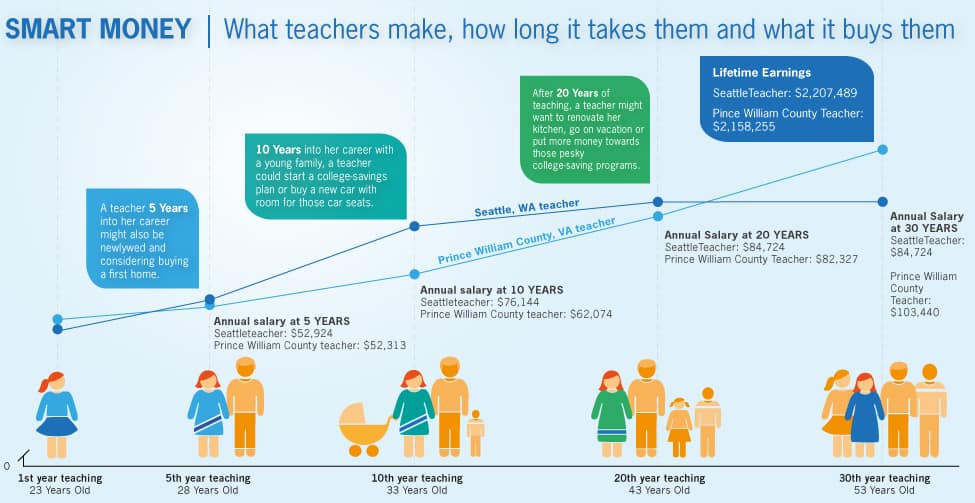Compensation determines not only the decision of teachers to enter the profession, but whether they stay in it. Teacher’s pay has been at the forefront of many strikes and walkouts, even though teachers earn a bit more than the average U.S. salary, with earnings of $63,645 per year compared to the national average of $56,310. These numbers, however, do not tell the whole story. School districts take different approaches to compensation, so the path to getting to those salaries on the higher end of the scale is different. Where can teachers earn the most money over the span of a full teaching career? How can they climb the ladder the fastest?
The top ten best states with the highest teaching salaries, compared to the average salary of all other occupations, are: Pennsylvania, New York, California, New Jersey, Iowa, Connecticut, Massachusetts, Oregon, Illinois, and Kentucky. Clearly, the East Coast of our nation has some of the best-paying states, including the state of New York where teachers can expect an average pay of $87,233, and the state of Pennsylvania where teachers earn the highest comparative pay of more than 30% above than average. The top ten worst states with the lowest teaching salaries compared to the average salary of all other occupations are: DC, Virginia, Colorado, Arizona, Florida, North Dakota, Minnesota, Missouri, Utah, and New Hampshire.
Teachers are still predominantly paid on what’s called ‘step and lane’ salary schedules. This means teachers earn a ‘step up’ in their salary for every year of additional experience and can move to a higher ‘lane’ through continuing education and training. For schools that use this system, it takes teachers, on average, twenty-four years to earn the maximum salary available based on their level of education and experience. So it might make sense for these schools to consider ways to have a shorter climb to the top.

- A specific starting or ending salary is not the same as a competitive salary structure for teachers as a whole.
- Teachers in higher paying districts also experience higher costs of living.
- Performance-pay systems are not necessarily better than the ‘step and lane’ salary schedules. Some allow you to climb faster but some do not offer clear guidelines on how to climb the ladder.
- It takes teachers an average of 24 years to reach their maximum salary. This differs greatly between states: from 7 years in Boston, MA to more than 30 in Wichita, KS.
If one thing is clear it’s that the steps teachers must take to increase their salaries should be the most important aspect of a teacher’s compensation program. Traditional ‘step and lane’ salary schedules depend entirely on education level and years of experience so they do not stimulate schools to generate a competitive edge when it comes to how they reward their employees. It does not reward teachers who go above and beyond, and it does not include the additional work and worry that many teachers put forward as they try to help students who are disadvantaged or being abused. When you include the personal purchases many teachers make to feed, clothe and supply many students so they can concentrate on learning, teacher’s salaries fall well below the value and strength they bring to our educational system.